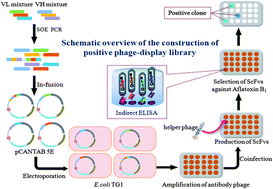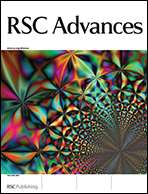A simple strategy to obtain ultra-sensitive single-chain fragment variable antibodies for aflatoxin detection†
Abstract
This paper describes a simple strategy to obtain ultra-sensitive single-chain fragment variable antibodies (scFv) against aflatoxin by constructing a positive phage-display library. A series of variable regions of heavy and light chains in monoclonal antibodies were randomly recombined to set up the library. Nearly 20 hybridoma cell lines that generate monoclonal antibodies against aflatoxins were first used, and then a library of 3.5 × 105 members was synthesized. The library was highly functional because high-quality scFv antibodies against aflatoxins had been isolated from the library. In addition, because of the high specificity of the DNA fragments forming the library, the anti-aflatoxin scFv antibodies could be rapidly obtained without traditional panning procedures. Based on preliminary indirect enzyme-linked immunosorbent assay (ELISA) screening data, the best candidate scFv antibodies 1A7 and 2G7 were subcloned for soluble expression. Indirect competitive ELISA was used to evaluate the sensitivity and cross-reactivity of the expressed products. The IC50 value of 1A7 was 0.02 ng ml−1, which was specific to four major kinds of aflatoxins, whereas that of 2G7 was 0.01 ng ml−1, which was highly specific to aflatoxin B1. Compared with the anti-aflatoxin recombinant scFv antibodies found based on the most significant evaluation results in recent publications, 1A7 and 2G7 were found to be over 20 times more sensitive, as described in this study.


 Please wait while we load your content...
Please wait while we load your content...